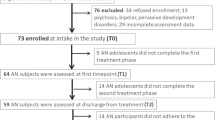Abstract
Objectives: The overall objective of this study was to measure the evolution of symptom severity in a residential programme based on a multidimensional approach to treatment that includes cognitive-behavioural, interpersonal, experiential and family therapies. The specific aims of the study were: 1) to evaluate changes in symptom severity in bulimic and anorexic patients between admission and discharge; 2) to compare the severity of these symptoms with those of non-patient college females (control group); and 3) to monitor the progression of symptom changes six months after discharge. Methods: The evolution of symptom severity was measured by comparing the mean raw scores of the Eating Disorder Inventory (EDI original inventory, 1983 version), which was administered at the beginning and end of the residential treatment. A subgroup of patients was also administered the EDI six months after discharge. The study involved 99 females: 47 with bulimia and 52 with anorexia as diagnosed by means of a clinical interview using DSM-IV criteria. The mean raw EDI scores in the control group (FC1, female college students) were obtained from the EDI manual. The population means were compared using the t-test for paired data (Microsoft Excel, version 2000). Results: The overall results for the population as a whole show that the eight subscales of the EDI improved significantly with treatment (<0.001). The subscales with the largest numerical improvements were drive for thinness, ineffectiveness and interoceptive awareness. When divided on the basis of diagnosis, the mean feelings of perfectionism score of the bulimic patients was less than that of the control female college sample; the symptoms of bulimia in the anorexic patients were similar to those found in the control group. The fact that the mean follow-up scores for a number of the EDI subscales remained similar to those recorded at the time of discharge suggests that some of the improvements in symptoms remained for at least six months. Conclusions: The results of our study show that multidimensional residential treatment leads to statistically significant changes in the severity of the symptoms manifested by females with eating disorders.
Similar content being viewed by others
References
Gamer D.M., Garfmkel P.E.: Handbook of Treatment for Eating Disorders, 2nd ed. New York, The Guilford Press, 1997.
Fairburn C.G., Nonnan P.A., Welch S.L., et al. A prospective study of outcome in bulimia nervosa and the long-term effects of three psychological treatments. Arch. Gen. Psychiatry, 52, 304–312, 1995.
Ricca V., Mannucci E., Zucchi T., Rotella C.M., Faravelli C.: Cognitive behavioural therapy for bulimia nervosa and binge eating disorder. A review. Psychother. Psychosom., 69, 287–295, 2000.
Agras W.S., Walsh T., Fairburn C.G., Wilson G.T., Kraemer H.C.: A multicenter comparison of cognitive-behavioral therapy and interpersonal psychotherapy for bulimia nervosa. Arch. Gen. Psychiatry, 57, 459–466, 2000.
Herzog D.B., Greenwood D.N., Dorer D.J., Flores A.T., Ekebiad E.R., Richards A., Blais M.A., Keller M.B.: Mortality in eating disorders: a descriptive study. Int. J. Eat. Disord., 28, 20–26, 2000.
Dare C., Eisler I., Russell G., Treasure J., Dodge L.: Psychological therapies for adults with anorexia nervosa: Randomised controlled trial of out-patient treatments. Br. J. Psychiatry, 178, 216–221, 2001.
Woodside D.B., Lackstrom J.B., Shekter-Wolfson L.: Marriage in eating disorders: comparisons between patients and spouses and changes over the course of treatment. J. Psychosom. Res., 49, 165–168, 2000.
Robinson P.H.: Review article: recognition and treatment of eating disorders in primary and secondary care. Aliment. Pharmacol. Ther., 14, 367–377, 2000.
Walsh J.M., Wheat M.E., Freund K.: Detection, evaluation, and treatment of eating disorders: the role of the primary care physician. J. Gen. Intern. Med., 15, 577–590, 2000.
Gamer M.G., Olmsted M.P., Polivy J.: Development and validation of a multidimensional eating disorder inventory for anorexia nervosa and bulimia. Int. J. Eat. Disord., 2, 15–34, 1983.
Traverso A., Ravera G., Lagattolla V., Testa S., Adami G.R.: Weight loss after dieting with behavioral modification for obesity: the predicting efficiency of some psychometric data. Eat. Weight Disord., 5, 102–107, 2000.
Bulik C.M., Sullivan P.F., Fear J.L., Pickering A.: Outcome of anorexia nervosa: eating attitudes, personality, and parental bonding. Int. J. Eat. Disord., 28, 139–147, 2000.
Bulik C.M., Sullivan P.F., Joyce P.R., Carter F.A., McIntosh V.V.: Predictors of 1-year treatment outcome in bulimia nervosa. Compr. Psychiatry, 39, 206–214, 1998.
Garner D.M., Fairburn C.G., Davis R.: Cognitive behavioral treatment of bulimia nervosa: a critical appraisal. Behav. Modification, 11, 398–431, 1987.
Levine D.M., Berenson M.L., Stephan D.: Statistics for managers using Microsoft Excel. Upper Saddle River, New Jersey, Prentice Hall, 2000, pp. 292–299.
Iorio D., Margiotta P., D’Orsi P., Bellini O., Boschi V.: The Eating Disorder Inventory in the evaluation of impaired eating behavior in subjects requesting nutritional consultation. Eat. Weight Disord., 5, 206–210, 2000.
Halmi K.A., Sunday S.R., Strober M., Kaplan A., Woodside D.B., Fichter M., Treasure J., Berrettini W.H., Kaye W.H.: Perfectionism in anorexia nervosa: variation by clinical subtype, obsessionality, and pathological eating behavior. Am. J. Psychiatry, 157, 1799–1805, 2000.
Kaye W.H., Klump K.L., Frank G.K., Strober M.: Anorexia and bulimia nervosa. Annu. Rev. Med., 51, 299–313, 2000.
Probst M., Vandereycken W., Van Coppenolle H., Pieters G.: Body experience in eating disorders before and after treatment: a follow-up study. Eur. Psychiatry, 14, 333–340, 1999.
Rizvi S.L., Stice E., Agras W.S.: Natural history of disordered eating attitudes and behaviors over a 6-year period. Int. J. Eat. Disord., 26, 406–413, 1999.
Lilenfeld L.R., Stein D., Bulik C.M., Strober M., Plotnicov K., Pollice C., Rao R., Merikangas K.R., Nagy L., Kaye W.H.: Personality traits among currently eating disordered, recovered and never ill first-degree female relatives of bulimic and control women. Psychol. Med., 30, 1399–1410, 2000.
Author information
Authors and Affiliations
Corresponding author
Rights and permissions
About this article
Cite this article
Bean, P., Weltzin, T. Evolution of symptom severity during residential treatment of females with eating disorders. Eat Weight Disord 6, 197–204 (2001). https://doi.org/10.1007/BF03339743
Received:
Accepted:
Published:
Issue Date:
DOI: https://doi.org/10.1007/BF03339743




